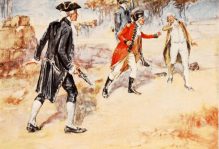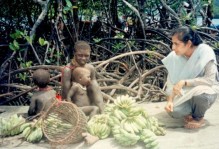Indian Soldiers who Made Their Last Battle Cry at Papua and New Guinea
The remains of the five unidentified Indian soldiers recovered during an mining excavation being buried in the Rabaul (Bita Paka) War Cemetery on 23 February 2012 with full honours. Notice the Indian tri-colour in the background. Photo Courtesy : Australian Army
Editor’s Note: About 7600 kms from homeland in a cluster of Islands called Papua and New Guinea, off the coat of Australia, a handful of Indian soldiers fought their last battle. They were the Prisoners of War taken by the Japanese Army in Singapore and transported to the Islands. They had refused to join the INA, preferring to stand by their oath of allegiance to the British Indian Army . Majority of them perished in the Islands. War heroes are made by the chroniclers of battle history, and the military historians have largely ignored them. But they were soldiers who fought a brave battle and retained their dignity even when defeated. We will not take a value judgement on whether their refusal to join the INA was wrong or right. A soldier’s bravery is irrespective of which side he fights for, it has a sense of absoluteness about it. And in remembering them we acknowledge the perseverance and courage which every soldier in a battlefield represents. This article has been written exclusively for Probashionline by Loy Dsouza, Consultant at the Auditor General’s Office, Papua New Guinea, and sent to us by Basab Roy, Accounts and Finance Professional with Curtain Bros, Papua and New Guniea.
Workers from the East New Britain construction company while excavating pumice near Kokopo (Papua and New Guinea) came across a curious finding. Five human skeletal remains were found and were suspected to be of soldiers from the World War II. The Australian Unrecovered War Casualty unit , which is responsible for investigating possibility of the recovery of unrecovered Australian servicemen was informed. At first instance the skeletal remains were assumed to be of Australian soldiers who had fought pitched battles with the Japanese when the latter had invaded Papua and New Guinea.
Indian Soldiers being processed at an Australian field ambulance after he was liberated by Americans at Los Negros in May 1944.
However what turned out was surprise. The bodies were subject to forensic examination and found to be that of Indian Prisoners of War captured by the Japanese. Who were these soldiers and how had they reached of all the places Papua and New Guniea.
About 40000 Indian soldiers were captured by the Japanese in Singapore. 30,000 agreed to join the INA, the remaining 10,000 who refused were transported to the various Islands of Papua and New Guinea. It is not easy to take a stance on whether these soldiers did a wrong thing by refusing to join the INA. They had sworn loyalty to the British Indian Army and decided to stick to the code of honour. They remain disowned in Indian military history, which otherwise puts a premium of solider’s loyalty.
Six companies of Indians were brought to Wewak in New Guinea and nine to Rabaul. According to Jemadar Chint Singh, a key witness in the story of Indians in New Guinea, the Indians were at first accommodated in a swamp about eight kilometers from Wewak Point, between the sea and a creek. Prisoners were compelled to build their own “totally inadequate” huts, hastily erecting them using grass offering little protection from heavy rain. Because no effective sanitary facilities could be constructed in the waterlogged camp the sick rate increased. The few Indian medical officers in the working parties had no medical equipment and were obliged to labour at the harbour unloading ships as part of their work.
Indians recovered near Rabaul bear the signs of the starvation, illness and brutality borne in captivity.
By April 1944 the Japanese became aware that American landings were likely along the Sepik coast. Many of the prisoners were ordered to march from Wewak through the coastal jungle toward Hollandia, 300 kilometers to the west, just inside the border of Dutch New Guinea.
The status of Indian prisoners of war became significant when they began to be recovered as MacArthur’s forces advanced along the northern coast of New Guinea. It is apparent that the presence of Indians on Los Negros came as a surprise to Allied authorities. Neither American nor Australian formations had any experience of Indian troops – who largely spoke Urdu rather than English. Passed along a medical chain of evacuation by unfamiliar personnel, they evidently repeatedly encountered difficulties in cultural and religious sensitivities. For example, even in October 1944, men of the 1st Bahawalpur Infantry were offered a meat curry by well-meaning Australians as they waited on the wharf to board the SS City of Lincoln to carry them home.The survivors were taken to Australia and left Sydney by ship for India in October 1944. In their home country they remained in ignominy.
An Australian officer described how “inspiring” it was to see a party of twenty prisoners arrive. “They are a great race”, he wrote, “Sikhs and Punjabis – great in adversity”.
Among the war crimes trials held in Rabaul(PNG) under Australian jurisdiction after the war, about half of the 127 cases dealt with the ill-treatment of Indian soldiers. The evidence of war crimes trials provides further evidence of the tenacity of a soldierly ethos among captive Indians. Near Rabaul in May 1945, for instance, Indian prisoners of 20 Indian Working Party were ordered to wear Japanese badges. While some of the other ranks complied, their officers reacted vigorously, ripping off the badges that had been pinned to their shirts and throwing them onto the ground. At his trial, Sergeant Major Yoshioka Makitaro admitted striking the Indian officers, on the orders of his officer. He was later found guilty of ill-treating prisoners and was sentenced to imprisonment.
So there we have it, another historic story being unearthed from the ‘Land of the Unexpected’. One can say that PNG ‘never ceases to amaze’. For those Indian forefathers who lost their lives, we earnestly salute you for your sacrifices. Even though history may have tried to forget you, we will not.
For those of us who have had the privilege to come to PNG, we pray that closer ties will continue between our two countries and that Indians will continue to assist PNG in building a healthy, wise and prosperous country for all Papua New Guineans to enjoy.
God Bless our two countries.
References:
John Baptist Crasta’s memoir, Eaten by the Japanese
Memoirs published by Jemadar Chint Singh, a key witness in the story of Indians in New Guinea
“Great in adversity”: Indian prisoners of war in New Guinea by Peter Stanley
Remembering the war in New Guinea & Forgotten soldiers in the Japanese army: MAEKAWA Kaori (Sophia University, Tokyo)





